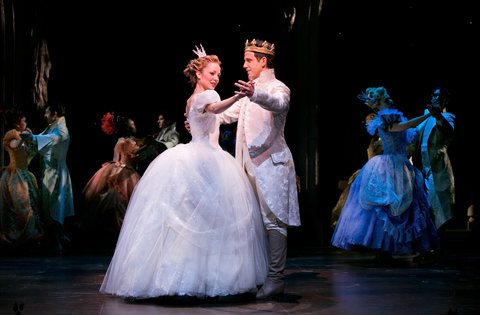

REVIEW: Cinderella
CRITIC: David Lefkowitz
REVIEWED: April 2013
SECTION: Broadway
GENRE: Musical
Show: Cinderella
Authors: Music: Richard Rodgers. Book: Douglas Carter Beane based on Oscar Hammerstein II’s original book. Lyrics: Oscar Hammerstein II
Director: Mark Brokaw
Choreography: Josh Rhodes
Rating: ***1/4
Theater: Broadway Theater
Dates: Opened March 3, 2013. Open run
CINDERELLA
How many balls does Cinderella have? No, that’s not the set-up for a tranny joke, it’s a question Douglas Carter Beane must have asked himself many times when adapting a 1957 Rodgers and Hammerstein television musical for the Broadway stage. In some traditional Cinderella stories, there are three huge parties, with the prince smearing the floor with pitch in the third so his new beloved can’t run away (her shoe gets stuck – you know the rest). In the 1950 Disney film, we get two French mice but only one ball, in which Cindy accidentally loses her shoe (you sort of know the rest). Librettist Beane splits the difference, giving us two balls and a wedding, thus meeting Broadway’s current requirement for big set pieces if attenuating the material to a not-always-enthralling two-and-a-half hours.
Still, the story is told and told with charm. Laura Osnes could hardly be more sweetly sympathetic as an abused stepdaughter or more fetching as a princess-to-be, while Santino Fontana’s likeable prince combines his Raúl Esparza-like looks with a winning charisma. After all, as Beane no doubt realized, a dashing but vapid, to-the-manner-born prince would not contribute as much to the story as a good-looking, well-meaning young fellow with room to grow into a proper leader. This production makes sure this Cinderella and this prince were made for each other, and that’s half the battle right there.
That said, one wishes Harriet Harris, as wicked stepmother Madame, were given more rousing material. The character seems caught between being funny/awful (a la Annie’s Miss Hannigan), and the real pathos Harris tries to inject into this twice-widowed woman. Late in act two, there’s a moment when Madame seems about to explain why she’s been such a rotter to `rella, but all she does is reiterate that she’d married her stepdaughter’s father for money (something she already said, in a funnier way, in act one). This leaves her character in a frustrating psychological limbo.
Beane does add an interesting touch to the stepsisters, however. Rather than make both equally spoiled and disdaining, he turns Charlotte into a sometimes-sympathetic comic villain (Ann Harada earns the show’s biggest laughs by adding a post-“Roseanne” ballsiness to her laments about not getting any breaks in the man-hunting department), and he allows Gabrielle (Marla Mindelle) to be fully compassionate and suffering from a downtroddenness of her own.
As ever, Victoria Clark is a welcome presence as a dotty old woman who turns out to be the fairy godmother. She flies, natch (on surprisingly visible strings), and shows up at just the right moments, though one can’t help but ask a basic logic question: if this benevolent spirit has known kind and considerate Cinderella for years, and she can conjure magic and she can turn woodland creatures into royal footmen, why couldn’t she get Cindy the hell out of her troubled home, make her a nice boyfriend, and maybe give her a cottage or two long before the story even starts? I know, it’s a fairytale, but still . . .
Anyway, much as in Shrek, mild political commentary about the kingdom’s haves and have-nots plays to the crowd. It’s no great shakes, but it does allow for a subplot between Madame and the prince’s scheming advisor (Peter Bartlett), as well as giving Cindy and Prince Topher a moral meeting ground (i.e., he likes her for her mind first). What does work are the hints at modern times that don’t quite cross the line into anachronism, as when the royal clarion announces after bellowing his “news cycle” that he’ll have “local weather and sports at eleven.”
Enough amusing touches like that help make the show pass engagingly if not swiftly, which is much the same with Rodgers and Hammerstein’s score. It certainly sounds like their classic work, though rarely do the songs announce themselves as lost classics themselves (and a couple drag on or add one too many reprised choruses). By the time the big ensemble number, “The Prince is Giving a Ball,” finally ends, we almost wish the ball would be cut off. Which reminds me of a joke . . .
David Lefkowitz